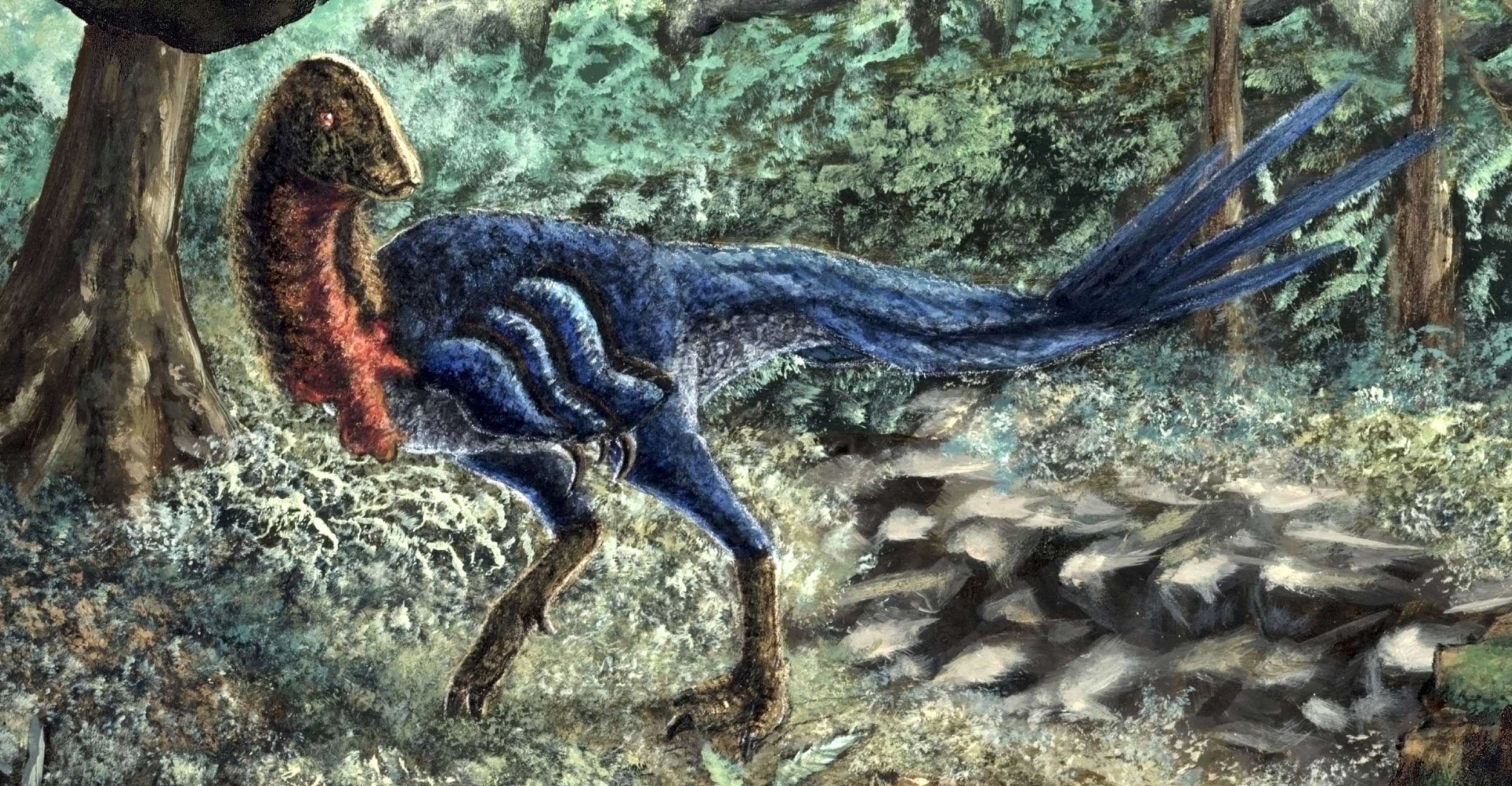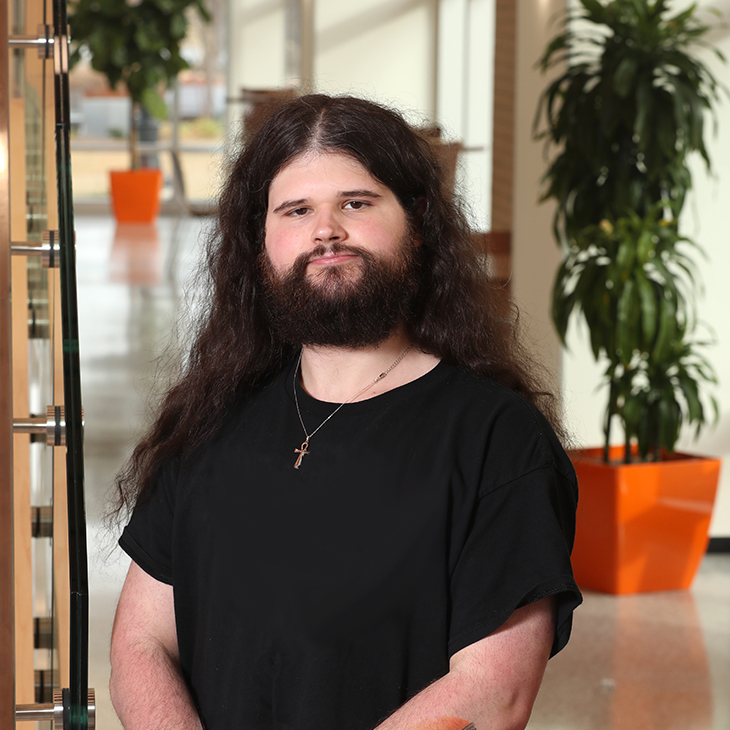
OSU-CHS student discovers new dinosaur species, publishes findings
Wednesday, January 24, 2024
Media Contact: Sara Plummer | Communications Coordinator | 918-561-1282 | sara.plummer@okstate.edu
Only a small number of people can say they’ve named a new dinosaur.
Now, Oklahoma State University Center for Health Sciences student Kyle Atkins-Weltman is part of that exclusive club.
Atkins-Weltman, an anatomy and vertebrate paleontology Ph.D. student in the School of Biomedical Sciences, was studying a small collection of foot and leg bone fossils of what was believed to be a juvenile Anzu wyliei, which was described as a “chicken from hell” when it was discovered in 2014.
But, histology tests of the bones conducted at OSU-CHS determined that it wasn’t a juvenile, but a different species in the dinosaur family caenagnathid.
Atkins-Weltman named the new dinosaur Eoneophron infernalis, which translates to Pharaoh’s dawn chicken from hell. The name honors the description of the Anzu as well as his late beloved pet, a Nile monitor lizard named Pharaoh.
Based on rough estimates, Eoneophron weighed around 150 to 160 pounds and stood about 3 feet tall at the hip, about the size of a human.
“It was a very birdlike dinosaur. It had a toothless beak and relatively short tail. It’s hard to tell its diet because of the toothless beak,” Atkins-Weltman said. “It definitely had feathers. It was covered in feathers and had wings.”

Atkins-Weltman’s paper on the new Eoneophron species was published in the peerreviewed journal PLOS ONE, released by the Public Library of Science, in January 2024.
“Kyle is the first student researcher at OSU-CHS to reveal, describe and name a new dinosaur,” said Associate Professor of Anatomy Eric Snively, Ph.D., and Atkins-Weltman’s faculty advisor.
Atkins-Weltman said he never intended to find a new species. In January 2020, he was analyzing foot and leg fossils to study the weight-bearing metatarsal, or toe, bones of the Anzu dinosaur. The fossils were found in the Hell Creek Formation that spans parts of Montana, Wyoming, and North and South Dakota and date back to the end of the Cretaceous period before dinosaurs went extinct.
“They were about 25% smaller than other Anzu fossils. We figured it was a juvenile Anzu,” he said. “I assumed it was an Anzu until the evidence showed it wasn’t.”
When it looked like the fossils may not belong to an Anzu, Atkins-Weltman turned to caenagnathid researchers Greg Funston, Ph.D., a paleontologist with the Royal Ontario Museum in Ontario, Canada, and paleontology Ph.D. candidate Jade Simons with the University of Toronto for their help and expertise.
He also called on the help of OSU-CHS Associate Professor of Anatomy Holly Woodward Ballard, Ph.D., whose own research utilizes paleohistology — the study of fossil bone microstructures. Through paleohistology techniques, they determined that the foot and leg bones were not structurally those of a juvenile, but of a more mature specimen, meaning a new dinosaur species in the caenagnathid family.
“It was really thrilling. Based on the work and research I do, I never thought I would be someone to discover a new dinosaur species,” he said.
Atkins-Weltman said his project and published findings would not have been possible without his co-authors and those who assisted him.
“It was the whole team of people — other scientists who have more experience in this family of dinosaurs. And Dr. Ballard’s histology was invaluable,” he said.
Snively said he was thrilled to help Atkins-Weltman discover a new dinosaur.
“OSU-CHS attracts amazing graduate students through our anatomy and vertebrate paleontology track, and Kyle is an inspiring pioneer,” he said.
“Kyle is the first student researcher at OSU-CHS to reveal, describe and name a new
dinosaur.”
Since the discovery of Eoneophron was announced, Atkins-Weltman and his research have been featured in state, national and international news outlets including “The Washington Post,” National Public Radio and BBC News, as well as dozens of science and paleontology websites and blogs generating millions of clicks and views.
“I was genuinely shocked with how much attention it got. I figured, being a relatively small dinosaur and not one of the big Tyrannosaurs or anything like that, it would make a very small splash,” he said. “It was very shocking to see how much media coverage this little fellow got. I’m blown away by it all.”
Atkins-Weltman said he will continue to conduct research as he pursues his doctoral degree at OSU-CHS. He hopes the excitement and media coverage of his discovery generates more attention to OSU’s anatomy and vertebrate paleontology track, as well as inspire other institutions to reevaluate their own fossil collections.
“It might help bring attention to the great work that all of my colleagues are doing, and that kind of attention can bring funding for research,” he said. “We might be able to build a more complete picture of these animals.”
Learn more about the anatomy and vertebrate paleontology track at OSU at the website.
Story by: Sara Plummer | STATE Magazine
Photos by: Matt Barnard, Kyle Atkins-Weltman
Artwork by: Zubin Erik Dutta
